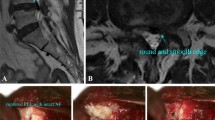Abstract
Currently, there are over 300,000 lumbar discectomies performed in the US annually without an objective standard for patient selection. A prospective clinical outcome study of 200 cases with 5-year follow-up was used to develop and validate an MRI-based classification scheme to eliminate as much ambiguity as possible. 100 consecutive lumbar microdiscectomies were performed between 1992 and 1995 based on the criteria for “substantial” herniation on MRI. This series was used to develop the MSU Classification as an objective measure of lumbar disc herniation on MRI to define “substantial”. It simply classifies herniation size as 1-2-3 and location as A-B-C, with inter-examiner reliability of 98%. A second prospective series of 100 discectomies was performed between 2000 and 2002, based on the new criteria, to validate this classification scheme. All patients with size-1 lesions were electively excluded from surgical consideration in our study. The Oswestry Disability Index from both series was better than most published outcome norms for lumbar microdiscectomy. The two series reported 96 and 90% good to excellent outcomes, respectively, at 1 year, and 84 and 80% at 5 years. The most frequent types of herniation selected for surgery in each series were types 2-B and 2-AB, suggesting the combined importance of both size and location. The MSU Classification is a simple and reliable method to objectively measure herniated lumbar disc. When used in correlation with appropriate clinical findings, the MSU Classification can provide objective criteria for surgery that may lead to a higher percentage of good to excellent outcomes.




Similar content being viewed by others
References
Asch HL, Lewis PJ, Moreland DB, Egnatchik JG, Yu YJ, Clabeaux DE, Hyland AH (2002) Prospective multiple outcomes study of outpatient lumbar microdiscectomy: should 75 to 80% success rates be the norm? J Neurosurg 96:34–44
Atlas SJ, Deyo RA, Patrick DL, Convery K, Keller RB, Singer DE (1996) The Quebec Task Force classification for spinal disorders and the severity, treatment, and outcomes of sciatica and lumbar spinal stenosis. Spine 21:2885–2892
Boden SD, Davis DO, Dina TS, Patronas NJ, Wiesel SW (1990) Abnormal magnetic-resonance scans of the lumbar spine in asymptomatic subjects. A prospective investigation. J Bone Joint Surg Am 72:403–408
Carragee EJ, Han MY, Suen PW, Kim D (2003) Clinical outcomes after lumbar discectomy for sciatica: the effects of fragment type and anular competence. J Bone Joint Surg Am A 85:102–108
Carragee EJ, Kim DH (1997) A prospective analysis of magnetic resonance imaging findings in patients with sciatica and lumbar disc herniation. Correlation of outcomes with disc fragment and canal morphology. Spine 22:1650–1660
Delamarter RB, McCulloch JA (1997) Microdiscectomy and microsurgical spinal laminotomies. In: Frymoyer JW (ed) The adult spine: principle and practice, 2nd edn. Lippincott-Raven, Philadelphia, pp 1961–1989
Fairbank JC, Couper J, Davies JB, O’Brien JP (1980) The Oswestry low back pain disability questionnaire. Physiotherapy 66:271–273
Fairbank JC, Pynsent PB (2000) The Oswestry Disability Index. Spine 25:2940–2952
Fardon DF, Milette PC (2001) Nomenclature and classification of lumbar disc pathology. Recommendations of the combined task forces of the North American Spine Society, American Society of Spine Radiology, and American Society of Neuroradiology. Spine 26:E93–E113
Jensen MC, Brant-Zawadzki MN, Obuchowski N, Modic MT, Malkasian D, Ross JS (1994) Magnetic resonance imaging of the lumbar spine in people without back pain. N Engl J Med 331:69–73
Karppinen J, Malmivaara A, Tervonen O, Paakko E, Kurunlahti M, Syrjala P, Vasari P, Vanharanta H (2001) Severity of symptoms and signs in relation to magnetic resonance imaging findings among sciatic patients. Spine 26:E149–E154
Kortelainen P, Puranen J, Koivisto E, Lahde S (1985) Symptoms and signs of sciatica and their relation to the localization of the lumbar disc herniation. Spine 10:88–92
Lotz JC (2004) Animal models of intervertebral disc degeneration: lessons learned. Spine 29:2742–2750
Marshall LL, Trethewie ER, Curtain CC (1977) Chemical radiculitis. A clinical, physiological and immunological study. Clin Orthop Relat Res 129:61–67
Mysliwiec L (1999) Keyhole lumbar microdiscectomy for substantial lumbar disc herniation: outcome study of one hundred consecutive cases with average five year follow-up. In: Proceedings of the 14th annual meeting of the North American Spine Society (NASS). Chicago
Ohnmeiss DD, Vanharanta H, Ekholm J (1997) Degree of disc disruption and lower extremity pain. Spine 22:1600–1605
Takada E, Takahashi M, Shimada K (2001) Natural history of lumbar disc hernia with radicular leg pain: spontaneous MRI changes of the herniated mass and correlation with clinical outcome. J Orthop Surg (Hong Kong) 9:1–7
Weber H (1983) Lumbar disc herniation. A controlled, prospective study with ten years of observation. Spine 8:131–140
Weinstein JN, Bronner KK, Morgan TS, Wennberg JE (2004) Trends and geographic variations in major surgery for degenerative diseases of the hip, knee, and spine. Health Aff (Millwood) Suppl Web Exclusives: VAR81-89
Weinstein JN, Tosteson TD, Lurie JD, Tosteson AN, Hanscom B, Skinner JS, Abdu WA, Hilibrand AS, Boden SD, Deyo RA (2006) Surgical vs nonoperative treatment for lumbar disk herniation: the Spine Patient Outcomes Research Trial (SPORT): a randomized trial. JAMA 296:2441–2450
Wiltse LL, Berger PE, McCulloch JA (1997) A system for reporting the size and location of lesions in the spine. Spine 22:1534–1537
Author information
Authors and Affiliations
Corresponding author
Rights and permissions
About this article
Cite this article
Mysliwiec, L.W., Cholewicki, J., Winkelpleck, M.D. et al. MSU Classification for herniated lumbar discs on MRI: toward developing objective criteria for surgical selection. Eur Spine J 19, 1087–1093 (2010). https://doi.org/10.1007/s00586-009-1274-4
Received:
Revised:
Accepted:
Published:
Issue Date:
DOI: https://doi.org/10.1007/s00586-009-1274-4




